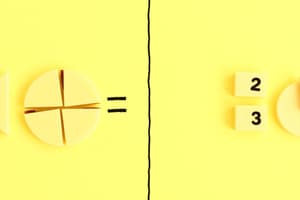Podcast
Questions and Answers
What is the first step when adding two fractions with unlike denominators?
What is the first step when adding two fractions with unlike denominators?
- Find a common denominator (correct)
- Convert the fractions to decimals
- Simplify the fractions
- Multiply the denominators
In the fraction \rac{5}{8} + rac{3}{10} = \rac{19}{20}, what was the common denominator used?
In the fraction \rac{5}{8} + rac{3}{10} = \rac{19}{20}, what was the common denominator used?
- 30
- 40
- 24
- 20 (correct)
What is the LCM of 9 and 15?
What is the LCM of 9 and 15?
- 30
- 54
- 25
- 45 (correct)
When adding fractions, what should you do after finding a common denominator?
When adding fractions, what should you do after finding a common denominator?
What is the result of simplifying \rac{18}{24}?
What is the result of simplifying \rac{18}{24}?
What is the result of adding \(rac{4}{9}\) and \(rac{7}{9}\)?
What is the result of adding \(rac{4}{9}\) and \(rac{7}{9}\)?
How would you visually represent \(rac{1}{5} + rac{3}{5}\)?
How would you visually represent \(rac{1}{5} + rac{3}{5}\)?
After adding \(rac{2}{7} + rac{5}{7}\), what is the simplified result?
After adding \(rac{2}{7} + rac{5}{7}\), what is the simplified result?
What is the common denominator when adding \(rac{4}{11} + rac{5}{11}\)?
What is the common denominator when adding \(rac{4}{11} + rac{5}{11}\)?
In the context of adding like fractions, what does the numerator represent?
In the context of adding like fractions, what does the numerator represent?
When simplifying a fraction, what should be done?
When simplifying a fraction, what should be done?
Flashcards are hidden until you start studying
Study Notes
Adding Like Fractions
Adding like fractions is a fundamental skill in mathematics, particularly when it comes to algebraic manipulation and solving equations. This process involves combining two or more fractions with identical denominators by performing arithmetic operations on their respective numerators. In this article, we will discuss how to add numerators, visual representations of adding like fractions, simplifying the result, and finding a common denominator.
Adding Numerators
To add two or more like fractions, you simply need to add the corresponding numerators while keeping the denominators unchanged. For example, if you have the fractions (\frac{5}{6}) and (\frac{7}{6}), you would combine them by adding 5 and 7, resulting in a new fraction: (\frac{5+7}{6}=\frac{12}{6}=\frac{12}{6}=2).
Visual Representations of Adding Like Fractions
Visualizing the addition of like fractions can help you better understand the concept. One common representation is using mental imagery or diagrams. For instance, consider (\frac{3}{8}+\frac{5}{8}=\frac{8}{8}=\frac{8}{8}=1). Another representation is through rectangles, where each rectangle represents one whole unit. Adding two rectangles of equal height corresponds to the sum of their heights, which is equivalent to the combined value of the two fractions.
Simplifying the Result
After adding the fractions, you may want to simplify the result if possible. This can be done by dividing both the numerator and the denominator by their greatest common divisor (GCD), or the largest number that divides both without leaving a remainder. For example, if you have (\frac{12}{6}=\frac{2}{1}), you have simplified the fraction since the numerator and denominator have been divided by their GCD, which is 6 in this case.
Finding a Common Denominator
When adding unlike fractions, you need to find a common denominator before performing the addition operation. This involves finding the least common multiple (LCM) of the denominators. For example, if you have (\frac{3}{4}) and (\frac{5}{6}), you would find the LCM of 4 and 6, which is 12. Then, you would convert each fraction to an equivalent fraction with a denominator of 12. In this case, (\frac{3}{4}=\frac{9}{12}) and (\frac{5}{6}=\frac{10}{12}). After that, you can perform the addition operation, resulting in a sum that is equivalent to (\frac{9}{12}+\frac{10}{12}=\frac{19}{12}).
Studying That Suits You
Use AI to generate personalized quizzes and flashcards to suit your learning preferences.




